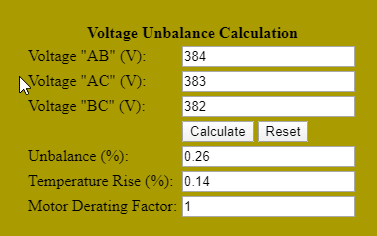Hi Bill
the current is a function of the motor impedance in relation to the supply impedance among other factors.
Let's say the voltage unbalance originates upstream of the relevant supply impedance. Then I would think that fractional effect upon unbalance current due to supply impedance is on the same order of magnitude as the fractional effect on motor starting current due to supply impedance (typically 10%, 20% or 30% unless it is a really weak power system… which I have had no exposure to working in a power plant). Here's my logic for predicting the effect of power supply impedance in reducing current unbalance is similar to the effect of power supply impedance in reducing starting current...
Any zero sequence impedance won’t enter into the problem because motor only sees phase to phase voltages whose vector diagram forms a closed triangle with no zero sequence (and I'm asusming voltage unbalance is calculated from phase to phase measurements). And the ungrounded wye connection of the motor prevents any zero sequence currents.
So the supply system impedance relevant for evaluating unbalance current flowing in repsonse to unbalanced voltage is the negative sequence impedance. For transformers and cables the negative sequence impedance is roughly the same as the positive sequence impedance (these devices react the same to negative sequence as they do to positive sequence, unlike the motor when spinning forward).
So unbalance voltage sees a comparable supply impedance (the negative sequence) to the normal positive sequence supply impedance which reduces starting current. And the negative sequence impedance of the motor is comparable to the starting impedance as I mentioned before. So the voltage divider among these impedances would be similar…. the reduction in unbalanced current due to supply impedance is roughly the same as typical reduction in starting current due to supply impedance.
At least that’s my take, always open to being corrected (I haven't given the phase angles of the impedances a lot of thought). I have no doubt you have a waaay better grasp on power system stuff than I do.
There is a lot of similarity in the action of a motor and the action of a grounded wye/delta transformer.
Both transfer power from the high phase(s) to the lower phase(s).
The higher current taken by the high phase tends to lessen the current that would otherwise be taken by the lower phase.
A suggested method of solution.
Compare the directed differences between the symmetrical back EMF and the applied unbalanced voltages.
I agree. The motor acts like a generator with respect to that symmetrical back EMF. That is why I tend to associate the unbalanced current with the magnetizing component of current which is load independent. This leads to the fact that a given voltage unbalance results in higher unbalanced current fraction at no load than full load (because the balanced load current increases with load but the unbalanced magnetizing current is constant with load).
OP - I did find a reference which may be helpful. Energy Efficient Electric Motors (Mercel Dekker 2005) figure 5.6 attached. If you read up from the 1% voltage unbalance line, you will see it predicts maybe 6-8% current unbalance at full load and 12-15% current unbalance at no load.
=====================================
(2B)+(2B)' ?


